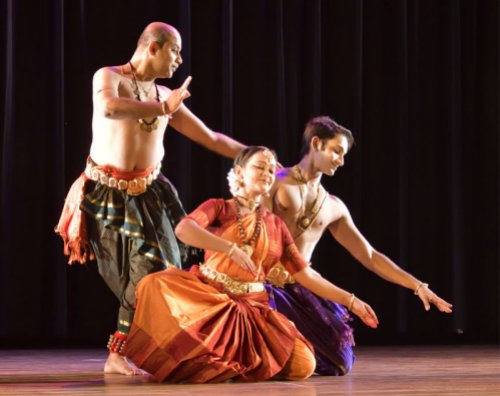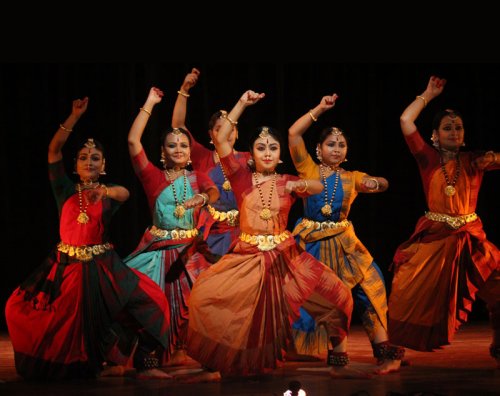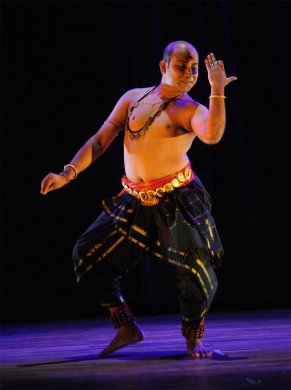
|   |

|   |
 e-mail: ukb7@rediffmail.com From roots to efflorescence November 11, 2017 It was the beginning of the beginning. If one places oneself at the earliest of Vedic traditions, one discovers the many gems in Rigveda abounding in Bari Suktam, Prakriti Suktam, Nasadiya Suktam, et al., outlining hymns of creation in the realm of cosmology. Granthan (Chronicling), presented recently by Parampara in Kolkata, saw Rittvik Bhattacharya - carrying on his very young shoulders the sacramental legacy of his devout grandfather - proceed from the farthest corner of the auditorium to sanctify the viewing space as well as the performance space. He did so by sprinkling water from his sacred pot and recited sonorously Purusha Suktam from Rigveda: The Purusha (Universal Being) has thousand heads, thousand eyes and thousand feet (thousand signifying innumerable and pointing to the omnipresence of the Universal Being); He envelops the world from all sides (that is, pervading each part of the creation), and extends beyond ten directions (represented by ten fingers)... Rittvik chanted about the genesis of Chaitanya (consciousness), the coalition of Purusha and Prakriti, and metamorphosis of Nirguna into Saguna to signify the emergence of the qualitative world. He recited the Shanti Mantra from Ishavashya Upanishad - a part of Shukla Yajurveda - as a figurative invocation: You are complete here, you are complete afar, completeness cannot be taken away from you, and even then you remain complete... Citing the omnibus Brihadaranyaka Upanishad - the most detailed and magnificent revelation of the ancient philosopher seers - Rittvik eulogized the sacrificial rites: You exist in the Yajna, your merits are limitless, you excel in energy, wealth and intelligence... and he concluded by invoking Gayatri Mantra to visualise symbolically: Let us adore the supremacy of that divine sun, the godhead who illuminates all, who recreates all, from whom all proceed, to whom all must return, whom we invoke to direct our understanding, our progress towards his holy being... 

The dance performance was woven with Surya Pranam moving seamlessly into Surya Dhyan by Rittvik. It was a delight to witness deft choreography: letting young dancers commingle variations of the yogic Surya Namaskar postures, subsequently, with pushpanjali and alarippu. The choreographer Rajdeep Banerjee - trained by Gangakanti of Chennai Kalakshetra and then groomed by Guru C.V. Chandrasekhar - explained later, "I was keen to blend my dance with human aspirations for salvation and for reaching the Almighty, as contemplated by the Vedic sages, in an all-pervading aura of spirituality." One dares say he largely succeeded, in a metaphorical sense. Next came the leit motif of the evening's repertoire, an elaborate tana varnam in raga Sunada Vinodini. An old composition by Ramachandran, it was an ode to Ganesha: Gananayaka varanamukham... Danced by Rajdeep along with the female dancers, it essentially portrayed a wonderful symmetry in an apparent tapestry of asymmetry. Unlike a pada varnam which contains lyrics that correspond to the muktayi swaras and chitta swaras of the varnam, a tana varnam has lyrics only for the pallavi, anupallavi and charanam, with swaras for the rest of the sections. As such, this presumably provides more liberty to the dancers to improvise. When asked, the choreographer confirmed this, adding: "I, personally, wanted to avoid feminine stances that come naturally to me in creating choreography. I chose tana varnam instead of pada varnam, since I'd have ample freedom to work round the male body concept." This was followed by the all-time favourite of Muthuswamy Dikshitar: Meenakshi me mudam dehi... in raga Puriya Kalyani. Composed in adulation of the many sterling attributes of the goddess Meenakshi of the great temple of Madurai, this is one of the crowning jewels from the saint-poet's oeuvre, particularly adored in Bengal for a most endearing adaptation of its melody by the poet Tagore in his song Basanti hey bhubana mohini... The incantation spelt out the conscious as well as unconscious facades of the divinity in the manifold aspects of dance. The flowering of the devotion laden choreography was complete when the margam reached its pinnacle in Lalgudi Jayaraman's tillana in raga Desh. It was one of the most rhythmic compositions in the Carnatic genre, while the sahitya was in praise of Muruga and his wedlock. "I wanted to put emphasis on the choice of Lakshana Prabandhas in the margam," averred Rajdeep. Excerpts from interview with the choreographer:  Rajdeep Banerjee What is the general Bharatanatyam scene in east India? It is very Chennai oriented. Dancers here love to visit Chennai, join one guru or the other, "buy" an item or two, and return to perform the same. There is not enough choreographic talent here. In contrast, Delhi and Mumbai have many meritorious choreographers and have competent music composers as well, which doesn't happen here. This situation makes me quite unhappy, when I want to say my own thing. Do dancers lack quality here? I would think so. To my mind, a dancer should be creative enough and understand songs, melody, costume and light, apart from choreography. They should be complete beings. Yes, dancers lack quality here: they learn Bharatanatyam, yet perform Tagore's style of dance! Is there overall lack of interest? Not at all, Bengalis are very culturally minded and any dance school is bound to get flooded with learners. I would say that quantity is high, but quality is low. Are there experimentations and innovations in choosing new themes in classical dances? It's not visible. Most classical dancers are confined to teentaal most of the time! Among other styles, Sharmila Biswas has been experimenting in Odissi, Bimbabati Devi in Manipuri and Ashimbandhu in Kathak.  Dr. Utpal K Banerjee is a scholar-commentator on performing arts over last four decades. He has authored 23 books on Indian art and culture, and 10 on Tagore studies. He served IGNCA as National Project Director, was a Tagore Research Scholar and is recipient of Padma Shri. Post your comments Please provide your name and email id when you use the Anonymous profile in the blog to post a comment. All appropriate comments posted with name & email id in the blog will also be featured in the site. |